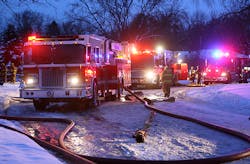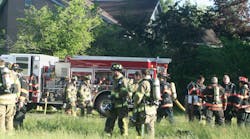LeDuc: Consolidation for Efficiencies and Service Synergies
Global economic realities have driven communities to examine opportunities to leverage public safety resources through collaboration. Operationally, many communities are challenged to rapidly place an adequate number of responders on the scene of a working fire or other critical incident. As we have demonstrated through NFPA standards and critical task studies, a specific concentration of first responders are necessary, within certain time parameters, to successfully extinguish fire safely and rescue trapped occupants before flashover occurs. Much has been previously written regarding the rapid rate of fire growth and flashover due to modern construction and combustible content and materials. The rapid assembly of an effective firefighting force of adequate size can be hampered by numerous factors, such as funding of adequate minimum staffing, apparatus and station deployment and concurrent call volume. Many communities are struggling with how to best provide the necessary number of firefighters on scene to safely accomplish all critical tasks to successfully resolve the crisis at hand.
Consolidation exploration is often driven by the search for fiscal efficiencies and savings...not surprisingly given the sustained economic realities faced by communities. Most consolidations identify savings through longer range cost avoidance strategies such as areas of personnel attrition, efficiencies in support functions, such as procurement, and other identified strategies. However, given the fiscal realities, perhaps a greater opportunity to view consolidation opportunities is through the prism of "force multiplier" for responders. The "force multiplier" synergy can take several forms from automatic aid to full consolidation.
The essential components, however, must be assured to be in place, such as seamless notification, communication and response. Also, essential to effective force multiplication is the need for a common platform of standard operating guidelines (SOG), equipment compatibility and regular joint training evolutions. An excellent example of the further need for "force multiplier" is the need to have an adequate sized rapid intervention team in place that is well equipped, trained and ready to affect a rescue. Studies conducted by the fire services in both Phoenix and Seattle have demonstrated that to successfully locate and rescue a downed firefighter, a well trained and sizable rapid intervention force is necessary. This proves to be a challenge in many communities and may be best approached through a consolidated effort.
As with any system, deployment evaluation or consolidation feasibility exploration and a careful analysis must be undertaken with analytics being the foundation. A system master plan, unit resource deployment analysis, and standard of covers are all vehicles to facilitate an objective analysis of system strengths, opportunities for improvement and collaborative potentials. System performance reviews and policy discussions surrounding the same should be guided by system performance data and reliability as opposed to emotional and anecdotal drivers. The utilization of data-driven analysis will assist in shaping a discussion more aimed towards firefighter and civilian safety and limiting fire growth and subsequent property damage.
Whether your system has considered, or perhaps should explore, consolidation is a local decision best driven by all stakeholders involved. However, it is incumbent on individual systems to objectively and analytically evaluate baseline system performance and establish on-going system performance monitoring. This is essential in identifying system needs and opportunities and is critical to the safety of your fire service and the community which you service.
If your data analysis identifies system performance opportunities, this will serve as a springboard for such a system's approach and one likely does not fit all communities. However, having the ability to know where the system performs is relative to national benchmarks for firefighter safety.







